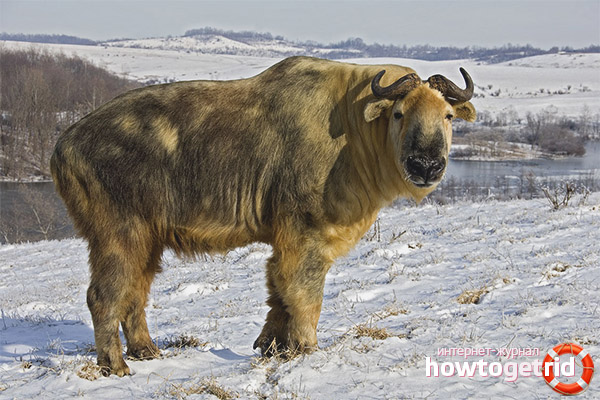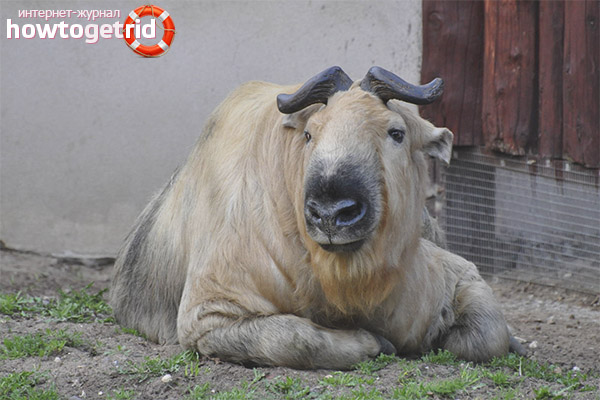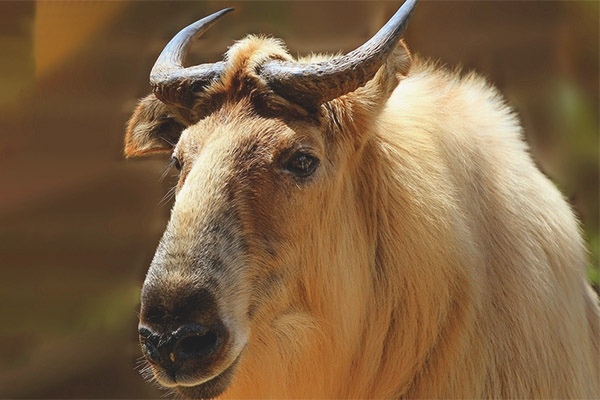The content of the article
Takin is the most obscure large-crested animal. It was studied for the first time only in 1985, when it appeared in the classification of zoologists and was more or less studied in detail by the famous scientist George Schaller.
Description and features takin
Its distinctive feature is the golden wool, which has an incredible beauty and distinguishes among all the other artiodactyls. Takin looks more like a moose that has a thick coat; it belongs to the bovid family. Zoologists refer these animals to the so-called transitional forms, which are something between two species, in particular, takins are a cross between a ram and a bull.
The Takin habitat occupies the territories of northeastern India, some regions of Nepal, Tibet, Bhutan, Sichuan Province of China, which is located in the southeastern part of central China.Depending on the region, appearance and some features may vary. For example, golden takin has the most beautiful wool, which has a full light color, and Szechuan takin is famous for its half color with golden and dark color.
Takins are mammals. According to the socio-sexual structure are polygamous, that is, they are changing partners and do not constitute stable marriage unions.
All of these animals are quite large and reach a mass of 350 kilograms, the horns are most similar to buffaloes, they are used to fend off predators and pose a significant danger.
These groups live in groups that consist of individuals from 30 to 130. In these groups there is a distribution of labor, for example, in the herd there may be a female who looks after all the calves, and the rest of the adults during this period are searching for food.
The dimensions of this animal are quite impressive and are up to a meter high at the withers. Body length varies between one and a half and two meters; females tend to be slightly smaller.
They rarely appear in front of people and prefer to go far into the mountains for many kilometers. For the most part, these animals eat green twigs and leaves, which are torn off from the bushes, and quite skillfully. For example, an adult takin (which weighs about 300 kilograms) can climb a steep slope 2-3 times higher than its height in order to get some greenery.
In addition, they are quite sympathetic to eating grass and moss. Periodically, they eat bark from trees and bamboo shoots that they take from under the snow. Takinam needs salt and other minerals, and for this they travel close to rivers full of salt water.
Population reduction
They are rather difficult to keep in captivity, they are hard to get used to the limited space of zoos and rather aggressively behave towards people. Therefore, to study takins in captivity is also quite difficult and not particularly productive.Nevertheless, these animals need to be carefully protected and protected, as the number of such animals is extremely small.
For quite a long time, the takins experienced significant pressure from people. First, the natural habitat decreased due to the destruction of the territory and the settlement of people. Secondly, poachers rather actively hunted Takins in order to get valuable wool or bring rare specimens to private zoos.
Then the Chinese acted quite reasonably and made these animals something like a national symbol and banned all kinds of hunting. In addition, it was in China that the largest reserves were opened for the breeding of takins.
Lifestyle & Habitat

Initially, these animals are inhabitants of the Asian continent and the Himalayan mountains. There they move through the snow-capped mountains, roam the forests full of bamboo and rhododendron. When the cold comes, the animals descend below to the foot of the mountains, the plains, which are located nearby, where they are looking for food.
As a rule, large herds are divided into more compact groups of about 20 individuals. Such groups are females, young males and young.
Separately, there are more adult and aged males, which do not unite with the common herd until the mating season. When spring comes again, takins gather in a large family and go high into the mountains.
Initially takins are more prone to living in cold conditions, for this their body has the appropriate "options":
- The nose perfectly warms the cold air before it reaches the lungs.
- The undercoat has a high thickness and warms perfectly.
- All the hair of the individual is saturated with lard, in connection with which it does not freeze and does not get wet.
- The skin produces a huge amount of fat that allows you to survive any blizzard.
Because of this, they can be tied to the same habitat space, which they follow. In fact, takins occupy new lands without pleasure. They prefer to stay in the known territory.
Takin character and reproduction

Although Takins are herbivores, they can be quite cruel in battles with enemies and scatter other animals many meters apart with their horns, causing heavy injuries. For the most part, they show courage and bravery, but they can also lay low.To this end, the takins remain in the thickets and lie there, disguising themselves to almost complete stealth.
As a rule, in herds there is a fairly clear gradation between the sexes, that is, the females and the males are arranged in separate groups, but when the mating season comes, which falls on the middle of summer, they begin to mix. Males in groups care for groups of females that, after fertilization, carry babies for seven months.
A five-kilogram baby appears in a single copy and can walk normally on the third day. This is essential, as the predators mainly attack the young Takins, because the adults are quite dangerous. On the second week of their existence, small takins begin to eat greens, and after eight weeks they significantly increase their diet, practically switching to an adult menu, but at the same time, without refusing breast milk.
Life expectancy is on average 15 years. However, it is not always possible to reach those of this age, as poachers actively continue to operate in the forests in order to obtain valuable meat and wool.Also, poachers continue to deliver takins to individuals who can afford to acquire and maintain these rare animals in their own home collection.
Video: takin (Budorcas taxicolor)











To send